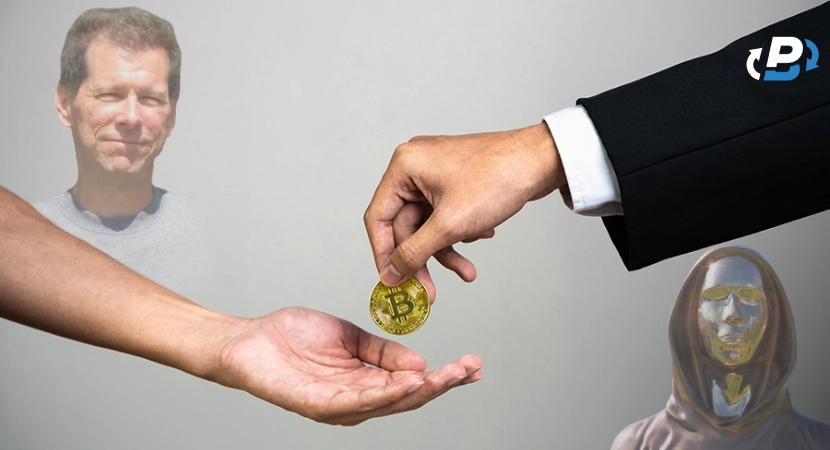The first-ever Bitcoin transaction marks a great milestone within the history of Bitcoin, and many of us wonder who sent it and who was at the receiving end of the transaction, but exactly what was the first Bitcoin Transaction? The first-ever commercial Bitcoin transaction was sent from Satoshi Nakamoto to Hal Finney, a revered cryptographer, on January 12th, 2009, and contained 10 Bitcoins. Unknown to them, they had just set the beginning of a financial revolution in motion that would continue until this very day. However, cryptocurrency transactions took place even before that, including the infamous ‘“Genesis Block’’ and even transactions made in completely different digital currencies. Find out all about the early days of Bitcoin in this in-depth article written by our cryptocurrency experts.
What Was the First Bitcoin Transaction’s Impact on the Digital Token’s Early Days?
Although the first commercial Bitcoin transaction took place on the 12th of January, 2009, Satoshi Nakamoto already pseudonymously published its whitepaper: Bitcoin: A Peer-to-Peer Electronic Cash System, on the domain name bitcoin.org as early as the 18th of August 2008. This blueprint of Bitcoin explicitly contained the words ‘’Peer-to-Peer’’ in its title, as Bitcoin was meant to be a digital monetary system in which transactions would take place directly from one person to another without the need for a third party.
The Bitcoin Whitepaper
The Bitcoin whitepaper continues to describe how all Bitcoin transactions, including buying and selling, would be possible without the need for a financial institution (bank) or government in between. The blockchain technique, as described in the whitepaper, makes it so that all persons or parties involved in a transaction are equal to each other. One of the most significant features of Bitcoin payment and transaction traffic to this day is that financial institutions like banks or notaries are not required. The indispensable trust in the digital BTC money system and its necessary security are realized in a different way. Namely, through a shared, immense network of computers around the world, in combination with cryptography, the blockchain, and proof-of-work. How? That is what Satoshi Nakamoto's white paper explains.
Cryptography and the Bitcoin Whitepaper
Many of us wonder what cryptography actually is. Although this is explained in great detail within the Bitcoin whitepaper, our Plasbit crypto experts shall outline the most crucial functions of its workings in this section of our What was the first Bitcoin transaction? article. Essentially, cryptography is a technique to create text or data that cannot be read or deciphered by unauthorized persons. By means of encryption, a message can be encrypted. Only the authorized person(s) can decipher the message.
How Does Blockchain Technology Come Into Play?
Apart from cryptography, Bitcoin uses so-called ‘’blockchain technology’’ to function. But what exactly is blockchain technology or blockchain in general? A blockchain is a digital database for storing transactions. A blockchain consists of digital blocks of information to which both parties actually agree during a transaction. This block of data is stored forever in the blockchain database. This database, in turn, is encrypted with cryptography within the global network of nodes, which consists of computers that participate in the network. These computers also check the accuracy and validity of each transaction. The participating PC nodes within the global Bitcoin blockchain network are called nodes for a reason. Each block within the chain contains information about the previous block, and each node has a copy of this. This essentially means that all nodes - only jointly - have full supervision without being able to commit fraud. A blockchain can be used for a cryptocurrency such as BTC. But an infinite number of other applications can also 'run' on a (different) blockchain database. Consider, for example, smart contracts on the Ethereum (ETH) network.
Satoshi’s Vision For a Proof of Work Protocol
What is Proof of Work? With a Proof of Work protocol, a party proves that it has invested a certain amount of computing power in a transaction within the cryptographic blockchain. In Nakamoto's Bitcoin whitepaper in 2008, Proof of Work was essential because it led to P2P consensus on transactions. These transactions are mathematically recorded and, therefore, undisputed and unchangeable without a third party.
Who Were the Most Important People During Bitcoin’s Early Days?
The most important people during Bitcoin’s early days and even before Bitcoin’s existence were undoubtedly (in no particular order) Hal Finney, David Chaum, Cynthia Dwork, Moni Naor, Adam Back, Wei Dai, and Nick Szabo. Although most people know of Bitcoin and think it was the first-ever commercially used digital currency, nothing is further away from the truth. In fact, David Chaum had worked on a similar project called eCash as early as the 1980s. However, this project never received traction as it still required banks, and thus third-party intermediaries, to work. Added to this, eCash was susceptible to technical flaws in its system, such as double spending and Sybil attacks. Our crypto experts at Plasbit will not discuss these highly advanced topics in detail but will outline the impact of other important people during Bitcoin’s early days instead.
Take Cynthia Dwork, for instance, an American computer scientist known for her research on privacy-preserving data analysis and the invention of differential privacy in the early and mid-2000s. Together with Moni Naor, she worked on non-malleable cryptography, which would later be used by Satoshi Nakamoto and possibly Hal Finney in Bitcoin’s peer-to-peer electronic cash system. Then we have Adam Back, with HashCash, a Proof-of-Work anti-spam system developed in 1997. Although highly effective, it had no double-spending protection and was, therefore, not viable as a commercial electronic cash system. Two people came up with systems that countered the infamous double-spending issue; being Wei Dai and Nick Szabo. They both developed scarcity-based cryptocurrencies, bMoney and Bit Gold, respectively. However, both systems weren’t resistant to Sybil attacks. In 2004, cryptographer and digital privacy activist Hal Finney made a massive breakthrough with his Reusable Proof of Work system, which was Sybil resistant and countered the double-spending issue because it was Byzantine fault-tolerant.
The Genesis Block and its Implications for the Future of Money
As you know by now, there were actually quite a few digital money systems before Bitcoin. However, none of these were fully foolproof, and none of them included an open cash book, completely transparent and for the whole world to see. This all changed on January 3, 2009, when Satoshi Nakamoto used the computational power of his setup to mine the first block of what we now call "the blockchain." This first publicly-recorded cryptocurrency transaction is called ‘’The Genesis Block’’ and contained the following message: ‘’The Times 03/Jan/2009 - Chancellor on brink of second bailout for banks.’’ This text referred to a headline in The Times back then and is seen by many experts, including Plasbit’s, as a derisive comment on the instability caused by the practice of fractional-reserve banking. One mustn't forget that times were harsh back then, as the whole world was just entering a new financial crisis due to the 2008 subprime mortgage bubble burst. Technically, banks had given loans out to people who couldn’t afford them and then sold these loans to investors, promising great returns.
However, it was then that the Bitcoin network, as we know it today, came into existence, as Satoshi had received a reward of 50 Bitcoins for mining its first block. Additionally, the first open-source Bitcoin client was uploaded on the 9th of January 2009 on SourceForge, which is still the world’s largest Open Source Software (OSS) development website, providing a centralized resource for managing projects and a wide range of services for free to its community, which counts more than a million registered developers. Shortly after, on January 12, 2009, Hal Finney became the first-ever receiving party of a Bitcoin transaction, receiving 10 entire Bitcoins from Satoshi Nakamoto’s mined coins in block 170 of the world’s first peer-to-peer Bitcoin transaction. It is estimated that Satoshi Nakamoto continued to mine over a million Bitcoins before vanishing into the ether and handing over the network alert key and control of the code repository to Gavin Andresen. Additionally, Andresen became the lead developer at the Bitcoin Foundation, an organization founded three years later in September 2012 to promote the usage of Bitcoin globally.

How Was Bitcoin Traded in the Early Days?
One might wonder how Bitcoin was traded during the early days. Well, you’re in for a ride. The New Liberty Standard Exchange recorded the first Bitcoin-for-dollar transactions in late 2009 at a price of $0,00099 per Bitcoin. That’s right, users on the Bitcointalk forum traded over 5,000 entire Bitcoins for $5,02 via PayPal. In essence, Bitcoin was traded at the astronomical price of about one-tenth of a dollar cent. [1] An interesting fact to know is that back in the early days of Bitcoin, there was no standard pricing data available as cryptocurrency exchanges didn’t exist, or at least did not function in the same way as they function today. People who traded Bitcoin back in the day used Mt. Gox, a platform for trading Magic: The Gathering cards instead. This platform was repurposed in 2010 to launch as a Bitcoin exchange, capitalizing on the growing interest in the digital currency.
Bitcoin Pizza Day - an Expensive 10,000 BTC Ppizza Order
Although you might not believe it, on May 22, 2010, a computer programmer based in Florida named Laszlo Hanyecz ordered 2 Papa John’s Pizzas for a whopping 10,000 Bitcoins. This is now considered to be the first-ever commercial Bitcoin transaction and is even celebrated by cryptocurrency enthusiasts as Bitcoin Pizza Day. This notable retail Bitcoin transaction was the result of Laszlo creating a thread in an online forum, offering the 10,000 Bitcoins to anyone who would order him two pizzas. Jeremy Sturdivant, another forum user from the UK, accepted the offer and ordered said pizza’s to Laszlo’s house in Jacksonville, Florida. The Bitcoins has a total value of around $40 back then and multiple millions of dollars today.
The Only Vulnerability in the Bitcoin Protocol
On the 6th of August, 2010, a major vulnerability within the Bitcoin protocol was noticed by its users. Normally, all transaction outputs would never exceed their inputs. However, a transaction whose outputs summed to more than 264 would ‘’overflow’’, causing the transaction author to be able to create endless amounts of Bitcoin. Soon after, on the 15th of August that year, the vulnerability was exploited by a user who originally spent half a Bitcoin to create 92 billion Bitcoins. However, within hours, the transaction was noticed by other Bitcoin network users, and the bug was fixed by forking the blockchain. Ever since the blockchain was forked, this transaction no longer appears in the blockchain of the Bitcoin network we use today and until this day this was the only security flaw ever found and exploited within the history of Bitcoin.
The Mysterious Identity of Satoshi Nakamoto
As you know by now, ‘’Satoshi Nakamoto’’ is presumed to be a pseudonym for the person or people who designed the original Bitcoin protocol in 2008 and launched its network in 2009. Nakamoto was also responsible for creating most of the Bitcoin software and posting technical updates on the Bitcoin forum. There has been a lot of speculation about Satoshi Nakamoto's true identity over the years, with possible suspects including Dai Wei, Nick Szabo, and Hal Finney, in particular. Other investigations suggest other candidates, such as Micheal Clear and Vili Lehdonvirta However, here at Plasbit, our experts examine the assumption that Hal Finney is the true Satoshi Nakamoto. First of all, he lived in the exact same city as Satoshi, Temple City, Florida, only 1.6 miles away. Satoshi has lived at the same address for decades and only had to leave from time to time due to his engineering work and contracts with the government. In addition, he was the first person on the receiving end of a Bitcoin transaction, presumably from Nakamoto. However, it was already possible to pre program emails to be sent at a later date back then, and one could easily assume that he was just using a public place like an internet cafe or publicly free to access university as ‘’second IP address or place’’ to test Bitcoin transactions from and to. Additionally, his commitment to the Bitcoin project was considerable.
He was an experienced developer and privacy advocate who had worked on very similar projects practically all of his life. For instance, after his graduation, he began his professional career as a software developer at Mattel Electronics, producing video games such as Armor Ambush, Adventures of Tron, Space Attack, and Astroblast. Later, he would join the Pretty Good Privacy (PGP) Corporation, founded by Phil Zimmermann, a company dedicated to developing the PGP protocol. This protocol is still widely-used today for email encryption. As Hal was the first employee of the PGP Corporation and worked there until his early retirement in 2011, it is not far-fetched to assume Hal knew perfectly well how to program emails to be sent at a later date. Whilst he was working at the PGP Corporation, it is known that Hal Finney developed a particular interest in cryptography. This passion soon led him to be one of the world’s most renowned cryptographers. Aware of the many issues related to digital privacy, he then joined multiple mailing lists and became the leader of several Anonymous Remailers. Anonymous Remailers were email servers that allowed emails to be sent without revealing their origin or true destination. Added to this, he regularly participated in sometimes heated discussions about technology in broadcast forums. After working a while at the PGP Corporation, he even joined the infamous Cypherpunks mailing list, which focused primarily on privacy and individual digital freedom issues. Over time, he also participated in multiple experiments aimed at creating anonymous digital currency.
Hal Finney’s Reusable Proof of Work (RPOW), Bitcoin’s Precursor
In 2004, Hal Finney created Reusable Proof of Work, or RPOW in short. This digital currency mechanism was inspired by his peers Adam Back from HashCash and Nick Szabo’s Collectible Theory. Although Reusable Proof of Work mostly remained at prototype stage, RPOW is still of significant importance in the history of Bitcoin and other digital currencies. In addition to being the first receiver of the first Bitcoin transaction, Hal Finney defended the Bitcoin project aggressively against all sorts of criticism. He also actively participated in the development of the project and he had worked on several software programs to strengthen the Bitcoin network’s security.
Why Hal Finney Could Indeed Be Satoshi Nakamoto
There are many theories on who the mysterious creator of Bitcoin is. However, most evidence actually does point out that it is indeed Hal Finney. His values, expertise, and active involvement in the project make him the most plausible candidate. Added to this, Hal Finney and his family lived near Dorian Nakamoto, from which he could have easily taken or based his pseudonym. On the other hand, Hal Finney always denied being Satoshi Nakamoto, and to be honest, there is - until this day - no concrete evidence that these two men actually share the same identity.
Amyotrophic Lateral Sclerosis (ALS) And the End of Hal Finney’s Life
On August 28, 2014, Hal Finneuy officially passed away. Five years prior, he was diagnosed with amyotrophic lateral sclerosis (ALS). This degenerative disease attacks brain cells and causes progressive paralysis of muscles responsible for one’s motoric. The diagnosis was a vast blow for Hal Finney, who back then dreamed of and practiced running a full marathon. Sadly, the disease caused him to take early retirement in 2011, and eventually, at the age of 48, with a very weak and almost fully paralyzed body, he passed away. One of the most unique things about his death is that he requested his body to be cryopreserved in the hope that science would bring him back to life one day in the future.
Conclusion
Having answered the question what was the first Bitcoin transaction?, we can conclude that the first Bitcoin transaction between Hal Finney and Satoshi Nakamoto is a super important step in the history of Bitcoin, and it set the stage for great things to come right after. As we have learned, Hal Finney’s life was a constant struggle for digital and physical freedom, which is what notably led him to join the Cypherpunk movement and launch his own digital currency. These facts could have easily led him to Bitcoin, a project he left his permanent mark on by becoming the validated first recipient to ever be on the receiving end of a Bitcoin transaction. The struggle for freedom became too harsh to bear when he contracted ALS, a disease that basically imprisoned him in his own body and deteriorating him. Yet, like a true advocate and soldier for privacy, he did everything he could to stay alive, cryopreserving his body, in the hope that he could, hopefully one day in the future, finish the work he started.







